A Review of Social–Ecological System Research and Geographical Applications
Abstract
1. Introduction
2. Perspective for Understanding Social–Ecological Systems
2.1. Interdisciplinary Research
2.2. Complex Adaptive Systems (CAS)
2.3. Coupling System
3. Social–Ecological Systems Research
3.1. SES Frameworks
| Types | Concept | Principle | Key Research Questions Appropriate for This Representation | Application in Case |
|---|---|---|---|---|
| Conceptual descriptive framework | Panarchy |
|
|
|
| CCF-PPSS | The framework takes public resource management theory and organizational behavior theory as its social foundation, introduces the condition factors of the ecosystem itself, and constructs a series of core variables such as resource units, resource systems, users, and governance systems, which directly affect the final outcome of the social–ecological system interaction |
|
| |
| MNCPF | Ecosystem services as the nexus between the supply and demand sides of the SES; establishes linkages between ecosystem services and human well-being; introduces factor drivers and feedback loops; takes into account spatial and temporal scales. |
| ||
| Phenomenological analytical framework | SESDF | The framework is based in common resources pool theory and collective action theory and is a collection of variables characterizing the resource, the resource system, users, and the governance system that have empirically been shown to affect collective action and sustainable common pool resource use |
| |
| SEASF | This framework is a tool for capturing the dynamic processes that generate socio-ecological phenomena. It extends the concept of action contexts to focus on socio-ecological system interactions and their linkages at various levels, emphasizing specific analysis of specific phenomena |
|
| |
| RSAF | An analytical framework to identify the regime shifts of SES based on changes in the relationships between SES components while also establishing empirical links with their drivers and local and spillover effects with a perspective of processes unfolding over time |
|
3.2. Commonalities and Characteristics of Frameworks
3.3. Research Methods and Tools
4. SES in Geographical Applications
4.1. Land System and Land Science
4.2. Landscape Pattern and Landscape Management
4.3. Natural Resource Management and Territorial Space Governance
5. Conclusions Remarks
Author Contributions
Funding
Institutional Review Board Statement
Informed Consent Statement
Data Availability Statement
Conflicts of Interest
References
- Biggs, R.; De Vos, A.; Preiser, R.; Clements, H.; Maciejewski, K.; Schlüter, M. The Routledge Handbook of Research Methods for Social-Ecological Systems; Taylor & Francis: Abingdon, UK, 2021. [Google Scholar]
- Steffen, W.; Richardson, K.; Rockström, J.; Cornell, S.E.; Fetzer, I.; Bennett, E.M.; Biggs, R.; Carpenter, S.R.; De Vries, W.; De Wit, C.A.; et al. Planetary Boundaries: Guiding Human Development on a Changing Planet. Science 2015, 347, 1259855. [Google Scholar] [CrossRef]
- McGinnis, M.D.; Ostrom, E. Social-ecological system framework: Initial changes and continuing challenges. Ecol. Soc. 2014, 19, 30. [Google Scholar] [CrossRef]
- Folke, C.; Biggs, R.; Norström, A.V.; Reyers, B.; Rockström, J. Social-ecological resilience and biosphere-based sustainability science. Ecol. Soc. 2016, 21, 41. [Google Scholar] [CrossRef]
- Tian, H.; Lu, C.; Pan, S.; Yang, J.; Miao, R.; Ren, W.; Yu, Q.; Fu, B.; Jin, F.-F.; Lu, Y.; et al. Optimizing resource use efficiencies in the food–energy–water nexus for sustainable agriculture: From conceptual model to decision support system. Curr. Opin. Environ. Sustain. 2018, 33, 104–113. [Google Scholar] [CrossRef]
- Liu, J.; Dietz, T.; Carpenter, S.R.; Alberti, M.; Folke, C.; Moran, E.; Pell, A.N.; Deadman, P.; Kratz, T.; Lubchenco, J.; et al. Complexity of Coupled Human and Natural Systems. Science 2007, 347, 1258832. [Google Scholar] [CrossRef]
- Ministry of Environmental Protection, PRC. Interim Regulations for Ecological Function Zoning; PRC: Manila, Philippines, 2003.
- Wang, S.; Fu, B.J.; Wu, X.T.; Wang, Y. Dynamics and sustainability of social-ecological systems in the Loess Plateau. Resour. Sci. 2020, 42, 96–103. [Google Scholar] [CrossRef]
- Wu, X.; Wei, Y.; Fu, B.; Wang, S.; Zhao, Y.; Moran, E.F. Evolution and effects of the social-ecological system over a millennium in China’s Loess Plateau. Sci. Adv. 2020, 6, eabc0276. [Google Scholar] [CrossRef]
- Bammer, G.; O’rourke, M.; O’connell, D.; Neuhauser, L.; Midgley, G.; Klein, J.T.; Grigg, N.J.; Gadlin, H.; Elsum, I.R.; Bursztyn, M.; et al. Expertise in research integration and implementation for tackling complex problems: When is it needed, where can it be found and how can it be strengthened? Palgrave Commun. 2020, 6, 5. [Google Scholar] [CrossRef]
- Folke, C. Resilience: The emergence of a perspective for social–ecological systems analyses. Glob. Environ. Chang. 2006, 16, 253–267. [Google Scholar] [CrossRef]
- Arrow, K.; Bolin, B.; Costanza, R.; Dasgupta, P.; Folke, C.; Holling, C.S.; Jansson, B.-O.; Levin, S.; Maler, K.-G.; Perrings, C.; et al. Economic growth, carrying capacity and the environment. Science 1995, 268, 520–521. [Google Scholar] [CrossRef]
- De Vos, A.; Biggs, R.; Preiser, R. Methods for understanding social-ecological systems: A review of place-based studies. Ecol. Soc. 2019, 24, 16. [Google Scholar] [CrossRef]
- Gain, A.K.; Giupponi, C.; Renaud, F.G.; Vafeidis, A.T. Sustainability of complex social-ecological systems: Methods, tools, and approaches. Reg. Environ. Chang. 2020, 20, 102. [Google Scholar] [CrossRef]
- Holling, C.S. Understanding the Complexity of Economic, Ecological, and Social Systems. Ecosystems 2001, 4, 390–405. [Google Scholar] [CrossRef]
- Steffen, W.; Persson, Å.; Deutsch, L.; Zalasiewicz, J.; Williams, M.; Richardson, K.; Crumley, C.; Crutzen, P.; Folke, C.; Gordon, L.; et al. The Anthropocene: From Global Change to Planetary Stewardship. Ambio 2011, 40, 739–761. [Google Scholar] [CrossRef]
- Berkes, F.; Folke, C. (Eds.) Linking Social and Ecological Systems: Management Practices and Social Mechanisms for Building Resilience; Cambridge University Press: New York, NY, USA, 1998. [Google Scholar]
- Wang, S.; Fu, B.; Zhao, W.; Liu, Y.; Wei, F. Structure, function, and dynamic mechanisms of coupled human–natural systems. Curr. Opin. Environ. Sustain. 2018, 33, 87–91. [Google Scholar] [CrossRef]
- Fischer, J.; Gardner, T.A.; Bennett, E.M.; Balvanera, P.; Biggs, R.; Carpenter, S.; Daw, T.; Folke, C.; Hill, R.; Hughes, T.P.; et al. Advancing sustainability through mainstreaming a social–ecological systems perspective. Curr. Opin. Environ. Sustain. 2015, 14, 144–149. [Google Scholar] [CrossRef]
- Colding, J.; Barthel, S. Exploring the social-ecological systems discourse 20 years later. Ecol. Soc. 2019, 24, 2. [Google Scholar] [CrossRef]
- Ostrom, E. A General Framework for Analyzing Sustainability of Social-Ecological Systems. Science 2009, 325, 419–422. [Google Scholar] [CrossRef] [PubMed]
- Clark, W.C.; Harley, A.G. Sustainability Science: Toward a Synthesis. Annu. Rev. Environ. Resour. 2020, 45, 331–386. [Google Scholar] [CrossRef]
- Tengö, M.; Brondizio, E.S.; Elmqvist, T.; Malmer, P.; Spierenburg, M. Connecting Diverse Knowledge Systems for Enhanced Ecosystem Governance: The Multiple Evidence Base Approach. AMBIO 2014, 43, 579–591. [Google Scholar] [CrossRef]
- Torralba, M.; Fagerholm, N.; Hartel, T.; Moreno, G.; Plieninger, T. A social-ecological analysis of ecosystem services supply and trade-offs in European wood-pastures. Sci. Adv. 2018, 4, eaar2176. [Google Scholar] [CrossRef] [PubMed]
- Preiser, R.; Biggs, R.; De Vos, A.; Folke, C. Social-ecological systems as complex adaptive systems: Organizing principles for advancing research methods and approaches. Ecol. Soc. 2018, 23, 46. [Google Scholar] [CrossRef]
- Rogers, K.H.; Luton, R.; Biggs, H.; Biggs, R.; Blignaut, S.; Choles, A.G.; Palmer, C.G.; Tangwe, P. Fostering Complexity Thinking in Action Research for Change in Social–Ecological Systems. Ecol. Soc. 2013, 18, 31. [Google Scholar] [CrossRef]
- Reyers, B.; Folke, C.; Moore, M.-L.; Biggs, R.; Galaz, V. Social-Ecological Systems Insights for Navigating the Dynamics of the Anthropocene. Annu. Rev. Environ. Resour. 2018, 43, 267–289. [Google Scholar] [CrossRef]
- Carpenter, S.R.; Mooney, H.A.; Agard, J.; Capistrano, D.; DeFries, R.S.; Diaz, S.; Dietz, T.; Duraiappah, A.K.; Oteng-Yeboah, A.; Pereira, H.M.; et al. Science for managing ecosystem services: Beyond the Millennium Ecosystem Assessment. Proc. Natl. Acad. Sci. USA 2009, 106, 1305–1312. [Google Scholar] [CrossRef] [PubMed]
- Schlüter, M.; Haider, L.J.; Lade, S.; Lindkvist, E.; Martin, R.; Orach, K.; Wijermans, N.; Folke, C. Capturing emergent phenomena in social-ecological systems: An analytical framework. Ecol. Soc. 2019, 24, 11. [Google Scholar] [CrossRef]
- Westley, F.; Olsson, P.; Folke, C.; Homer-Dixon, T.; Vredenburg, H.; Loorbach, D.; Thompson, J.; Nilsson, M.; Lambin, E.; Sendzimir, J.; et al. Tipping Toward Sustainability: Emerging Pathways of Transformation. AMBIO 2011, 40, 762–780. [Google Scholar] [CrossRef]
- Scheffer, M.; Carpenter, S.R.; Lenton, T.M.; Bascompte, J.; Brock, W.; Dakos, V.; van de Koppel, J.; van de Leemput, I.A.; Levin, S.A.; van Nes, E.H.; et al. Anticipating Critical Transitions. Science 2012, 338, 344–348. [Google Scholar] [CrossRef]
- Hughes, T.P.; Carpenter, S.; Rockström, J.; Scheffer, M.; Walker, B. Multiscale regime shifts and planetary boundaries. Trends Ecol. Evol. 2013, 28, 389–395. [Google Scholar] [CrossRef]
- Lansing, J.S. Complex Adaptive Systems. Annu. Rev. Anthropol. 2003, 32, 183–204. [Google Scholar] [CrossRef]
- Gunderson, L.H.; Holling, C.S. Panarchy: Understanding Transformations in Human and Natural Systems; Island Press: Washington, DC, USA, 2002. [Google Scholar]
- Biggs, R.; Schlüter, M.; Biggs, D.; Bohensky, E.; BurnSilver, S.; Cundill, G.; Dakos, V.; Daw, T.; Evans, L.; Kotschy, K.; et al. Toward principles for enhancing the resilience of ecosystem services. Annu. Rev. Environ. Resour. 2012, 37, 421–448. [Google Scholar] [CrossRef]
- Biggs, R.; Rhode, C.; Archibald, S.; Kunene, L.M.; Mutanga, S.S.; Nkuna, N.; Ocholla, P.O.; Phadima, L.J. Strategies for managing complex social-ecological systems in the face of uncertainty: Examples from South Africa and beyond. Ecol. Soc. 2015, 20, 52. [Google Scholar] [CrossRef]
- An, L. Modeling human decisions in coupled human and natural systems: Review of agent-based models. Ecol. Model. 2012, 229, 25–36. [Google Scholar] [CrossRef]
- Liu, J.; Mooney, H.; Hull, V.; Davis, S.J.; Gaskell, J.; Hertel, T.; Lubchenco, J.; Seto, K.C.; Gleick, P.; Kremen, C.; et al. Systems integration for global sustainability. Science 2015, 347, 1258832. [Google Scholar] [CrossRef]
- Hertz, T.; Garcia, M.M.; Schlüter, M. From nouns to verbs: How process ontologies enhance our understanding of social-ecological systems understood as complex adaptive systems. People Nat. 2020, 2, 328–338. [Google Scholar] [CrossRef]
- Lambin, E.F.; Turner, B.L.; Geist, H.J.; Agbola, S.B.; Angelsen, A.; Bruce, J.W.; Coomes, O.T.; Dirzo, R.; Fischer, G.; Folke, C.; et al. The causes of land-use and land-cover change: Moving beyond the myths. Glob. Environ. Chang. 2001, 11, 261–269. [Google Scholar] [CrossRef]
- Liu, J.; Yang, W.; Li, S. Framing ecosystem services in the telecoupled Anthropocene. Front. Ecol. Environ. 2016, 14, 27–36. [Google Scholar] [CrossRef]
- Mauser, W.; Klepper, G.; Rice, M.; Schmalzbauer, B.S.; Hackmann, H.; Leemans, R.; Moore, H. Transdisciplinary Global Change Research: The Co-creation of Knowledge for Sustainability. Curr. Opin. Environ. Sustain. 2013, 5, 420–431. [Google Scholar] [CrossRef]
- Reyers, B.; Selig, E.R. Global targets that reveal the social–ecological interdependencies of sustainable development. Nat. Ecol. Evol. 2020, 4, 1011–1019. [Google Scholar] [CrossRef]
- Mancilla García, M.; Hertz, T.; Schlüter, M.; Preiser, R.; Woermann, M. Adopting Process-relational Perspectives to Tackle the Challenges of Social-Ecological Systems Research. Ecol. Soc. 2020, 25, 29. [Google Scholar] [CrossRef]
- Bourgeron, P.; Kliskey, A.; Alessa, L.; Loescher, H.; Krauze, K.; Virapongse, A.; Griffith, D.L. Understanding large- scale, complex, human–environmental processes: A framework for social–ecological observatories. Front. Ecol. Environ. 2018, 16 (Suppl. S1), S52–S66. [Google Scholar] [CrossRef]
- Van Riper, C.J.; Thiel, A.; Penker, M.; Braito, M.; Landon, A.C.; Thomsen, J.M.; Tucker, C.M. Incorporating multilevel values into the social-ecological systems framework. Ecol. Soc. 2018, 23, 25. [Google Scholar] [CrossRef]
- Binder, C.R.; Hinkel, J.; Bots, P.W.G.; Pahl-Wostl, C. Comparison of Frameworks for Analyzing Social-ecological Systems. Ecol. Soc. 2013, 18, 26. [Google Scholar] [CrossRef]
- McGinnis, M.D. An Introduction to IAD and the Language of the Ostrom Workshop: A Simple Guide to a Complex Framework. Policy Stud. J. 2011, 39, 169–183. [Google Scholar] [CrossRef]
- Holdschlag, A.; Ratter, B.M.W. Multiscale system dynamics of humans and nature in The Bahamas: Perturbation, knowledge, panarchy and resilience. Sustain. Sci. 2013, 8, 407–421. [Google Scholar] [CrossRef]
- Folke, C.; Carpenter, S.R.; Walker, B.H. Resilience thinking: Integrating resilience, adaptability and transformability. Ecol. Soc. 2010, 15, 20. [Google Scholar] [CrossRef]
- Cosens, B.A.; Gunderson, L.; Chaffin, B.C. Introduction to the Special Feature Practicing Panarchy: Assessing legal flexibility, ecological resilience, and adaptive governance in regional water systems experiencing rapid environmental change. Ecol. Soc. 2018, 23, 4. [Google Scholar] [CrossRef]
- Gunderson, L. Ecological and Human Community Resilience in Response to Natural Disasters. Ecol. Soc. 2010, 15, 18. [Google Scholar] [CrossRef]
- Zhang, L.; Huang, Q.; He, C.; Yue, H.; Zhao, Q. Assessing the dynamics of sustainability for social-ecological systems based on the adaptive cycle framework: A case study in the Beijing-Tianjin-Hebei urban agglomeration. Sustain. Cities Soc. 2021, 70, 102899. [Google Scholar] [CrossRef]
- Fu, B.; Wu, X.; Wang, Z.; Wu, X.; Wang, S. Coupling Human and Natural Systems for Sustainability: Experiences from China’s Loess Plateau. Earth Syst. Dyn. 2022, 13, 795–808. [Google Scholar] [CrossRef]
- Fu, B.; Wei, Y. Editorial overview: Keeping fit in the dynamics of coupled natural and human systems. Curr. Opin. Environ. Sustain. 2018, 33, A1–A4. [Google Scholar] [CrossRef]
- MEA. Ecosystem and Human Well-Being; Island Press: Washington, DC, USA, 2005; Volume 5. [Google Scholar]
- Li, S.C. On How to Measure the Contribution of Nature to Human Beings Scientifically—A Social-ecosystem Analysis Framework based on Ecosystem Services and Its Application. Frontiers 2020, 11, 28–35. [Google Scholar]
- Pan, H.; Page, J.; Cong, C.; Barthel, S.; Kalantari, Z. How ecosystems services drive urban growth: Integrating nature-based solutions. Anthropocene 2021, 35, 100297. [Google Scholar] [CrossRef]
- Díaz, S.; Pascual, U.; Stenseke, M.; Martín-López, B.; Watson, R.T.; Molnár, Z.; Hill, R.; Chan, K.M.; Baste, I.A.; Brauman, K.A.; et al. Assessing Nature’s Contributions to People. Science 2018, 359, 270–272. [Google Scholar] [CrossRef] [PubMed]
- Gain, A.K.; Ashik-Ur-Rahman, M.; Vafeidis, A. Exploring human-nature interaction on the coastal floodplain in the Ganges-Brahmaputra delta through the lens of Ostrom’s social-ecological systems framework. Environ. Res. Commun. 2019, 1, 051003. [Google Scholar] [CrossRef]
- Carpenter, S.R.; Folke, C.; Norström, A.; Olsson, O.; Schultz, L.; Agarwal, B.; Balvanera, P.; Campbell, B.; Castilla, J.C.; Cramer, W.; et al. Program on Ecosystem Change and Society: An International Research Strategy for In-tegrated Social-Ecological Systems. Curr. Opin. Environ. Sustain. 2012, 4, 134–138. [Google Scholar] [CrossRef]
- Leslie, H.M.; Basurto, X.; Nenadovic, M.; Sievanen, L.; Cavanaugh, K.C.; Cota-Nieto, J.J.; Erisman, B.E.; Finkbeiner, E.; Hinojosa-Arango, G.; Moreno-Báez, M.; et al. Operationalizing the social-ecological systems framework to assess sustainability. Proc. Natl. Acad. Sci. USA 2015, 112, 5979–5984. [Google Scholar] [CrossRef]
- Feng, J.; Zhao, Z.; Wen, Y.; Hou, Y. Organically Linking Green Development and Ecological Environment Protection in Poyang Lake, China Using a Social-Ecological System (SES) Framework. Int. J. Environ. Res. Public Health 2021, 18, 2572. [Google Scholar] [CrossRef]
- Schmitt-Harsh, M.L.; Mincey, S.K. Operationalizing the social-ecological system framework to assess residential forest structure: A case study in Bloomington, Indiana. Ecol. Soc. 2020, 25, 14. [Google Scholar] [CrossRef]
- Chong, H.; Panzhu, L. Application and Prospect of Social-ecological System Framework in Worldwide Forest Governance Researches. World For. Res. 2021, 35, 1–7. [Google Scholar] [CrossRef]
- Basurto, X.; Gelcich, S.; Ostrom, E. The social–ecological system framework as a knowledge classificatory system for benthic small-scale fisheries. Glob. Environ. Chang. 2013, 23, 1366–1380. [Google Scholar] [CrossRef]
- Boonstra, W.J.; de Boer, F.W. The Historical Dynamics of Social–Ecological Traps. Ambio 2014, 43, 260–274. [Google Scholar] [CrossRef]
- Enfors, E. Social–ecological traps and transformations in dryland agro-ecosystems: Using water system innovations to change the trajectory of development. Glob. Environ. Chang. 2012, 23, 51–60. [Google Scholar] [CrossRef]
- Bahl, J.; Pham, T.T.; Hill, N.J.; Hussein, I.T.M.; Ma, E.J.; Easterday, B.C.; Halpin, R.A.; Stockwell, T.B.; Wentworth, D.E.; Kayali, G.; et al. Ecosystem Interactions Underlie the Spread of Avian Influenza A Viruses with Pandemic Potential. PLoS Pathog. 2016, 12, e1005620. [Google Scholar] [CrossRef] [PubMed]
- Zhang, X.; Brandt, M.; Tong, X.; Ciais, P.; Yue, Y.; Xiao, X.; Zhang, W.; Wang, K.; Fensholt, R. A large but transient carbon sink from urbanization and rural depopulation in China. Nat. Sustain. 2022, 5, 321–328. [Google Scholar] [CrossRef]
- Yang, D. Restructuring of Rural Space in Loess Hilly-Gully Region of Northern Shaanxi Based on the Perspective of Social -Ecological System; Xi’an University of Architecture and Technology: Xi’an, China, 2021. [Google Scholar]
- Lhoest, S.; Vermeulen, C.; Fayolle, A.; Jamar, P.; Hette, S.; Nkodo, A.; Maréchal, K.; Dufrêne, M.; Meyfroidt, P. Quantifying the Use of Forest Ecosystem Services by Local Populations in Southeastern Cameroon. Sustainability 2020, 12, 2505. [Google Scholar] [CrossRef]
- Angelstam, P.; Andersson, K.; Annerstedt, M.; Axelsson, R.; Elbakidze, M.; Garrido, P.; Grahn, P.; Jönsson, K.I.; Pedersen, S.; Schlyter, P.; et al. Solving Problems in Social-Ecological Systems: Definition, Practice and Barriers of Transdisciplinary Research. Ambio 2013, 42, 254–265. [Google Scholar] [CrossRef]
- Roux, D.J.; Nel, J.L.; Cundill, G.; O’farrell, P.; Fabricius, C. Transdisciplinary research for systemic change: Who to learn with, what to learn about and how to learn. Sustain. Sci. 2017, 12, 711–726. [Google Scholar] [CrossRef]
- Hand, B.K.; Flint, C.G.; Frissell, C.; Muhlfeld, C.C.; Devlin, S.P.; Kennedy, B.P.; Crabtree, R.L.; McKee, W.A.; Luikart, G.; Stanford, J. A social–ecological perspective for riverscape management in the Columbia River Basin. Front. Ecol. Environ. 2018, 16, 23–33. [Google Scholar] [CrossRef]
- Hossain, S.; Ramirez, J.; Szabo, S.; Eigenbrod, F.; Johnson, F.A.; Speranza, C.I.; Dearing, J. Participatory modelling for conceptualizing social-ecological system dynamics in the Bangladesh delta. Reg. Environ. Chang. 2020, 20, 28. [Google Scholar] [CrossRef]
- Bodin, Ö.; Nohrstedt, D.; Baird, J.; Summers, R.; Plummer, R. Working at the “speed of trust”: Pre-existing and emerging social ties in wild-fire responder networks in Sweden and Canada. Reg. Environ. Chang. 2019, 19, 2353–2364. [Google Scholar] [CrossRef]
- Yoon, J.; Klassert, C.; Selby, P.; Lachaut, T.; Knox, S.; Avisse, N.; Harou, J.; Tilmant, A.; Klauer, B.; Mustafa, D.; et al. A coupled human–natural system analysis of freshwater security under climate and population change. Proc. Natl. Acad. Sci. USA 2021, 118, e2020431118. [Google Scholar] [CrossRef]
- Tatiana Filatova, J.; Polhill, G.; van Ewijk, S. Regime shifts in coupled socio-environmental systems: Review of modelling challenges and approaches. Environ. Model. Softw. 2016, 75, 333–347. [Google Scholar] [CrossRef]
- Sun, Y.; Liu, S.; Shi, F.; An, Y.; Li, M.; Liu, Y. Spatio-temporal variations and coupling of human activity intensity andecosystem services based on the four-quadrant model on theQinghai-Tibet Plateau. Sci. Total Environ. 2020, 743, 140721. [Google Scholar]
- Haider, L.J.; Hentati-Sundberg, J.; Giusti, M.; Goodness, J.; Hamann, M.; Masterson, V.; Meacham, M.; Merrie, A.; Ospina, D.; Schill, C.; et al. The undisciplinary journey: Early-career perspectives in sustainability science. Sustain. Sci. 2017, 13, 191–204. [Google Scholar] [CrossRef]
- Uehara, T.; Hidaka, T.; Tsuge, T.; Sakurai, R.; Cordier, M. An adaptive social-ecological system management matrix for guiding ecosystem service improvements. Ecosyst. Serv. 2021, 50, 101312. [Google Scholar] [CrossRef]
- Lázár, A.N.; Nicholls, R.J.; Hall, J.W.; Barbour, E.J.; Haque, A. Contrasting development trajectories for coastal Bangladesh to the end of century. Reg. Environ. Chang. 2020, 20, 93. [Google Scholar] [CrossRef]
- Levin, S.; Xepapadeas, T.; Crépin, A.S.; Norberg, J.; De Zeeuw, A.; Folke, C.; Hughes, T.; Arrow, K.; Barrett, S.; Daily, G.; et al. Social-ecological systems as complex adaptive systems: Modeling and policy implications. Environ. Dev. Econ. 2013, 18, 111–132. [Google Scholar] [CrossRef]
- Deslatte, A.; Szmigiel-Rawska, K.; Tavares, A.F.; Ślawska, J.; Karsznia, I.; Łukomska, J. Land use institutions and social-ecological systems: A spatial analysis of local landscape changes in Poland. Land Use Policy 2022, 114, 105937. [Google Scholar] [CrossRef]
- Partelow, S. A review of the social-ecological systems framework: Applications, methods, modifications, and challenges. Ecol. Soc. 2018, 23, 36. [Google Scholar] [CrossRef]
- Cumming, G.S.; Epstein, G.; Anderies, J.M.; Apetrei, C.I.; Baggio, J.; Bodin, Ö.; Chawla, S.; Clements, H.S.; Cox, M.; Egli, L.; et al. Advancing Understanding of Natural Resource Governance Using the Social Ecological Systems Framework: A Post-Ostrom Research Agenda. Curr. Opin. Environ. Sustain. 2020, 44, 26–34. [Google Scholar] [CrossRef]
- Díaz, S.; Demissew, S.; Carabias, J.; Joly, C.; Lonsdale, M.; Ash, N.; Larigauderie, A.; Adhikari, J.R.; Arico, S.; Báldi, A.; et al. The IPBES Conceptual Framework—Connecting nature and people. Curr. Opin. Environ. Sustain. 2014, 14, 1–16. [Google Scholar] [CrossRef]
- Crona, B.; Van Holt, T.; Petersson, M.; Daw, T.; Buchary, E. Using social–ecological syndromes to understand impacts of international seafood trade on small-scale fisheries. Glob. Environ. Chang. 2015, 35, 162–175. [Google Scholar] [CrossRef]
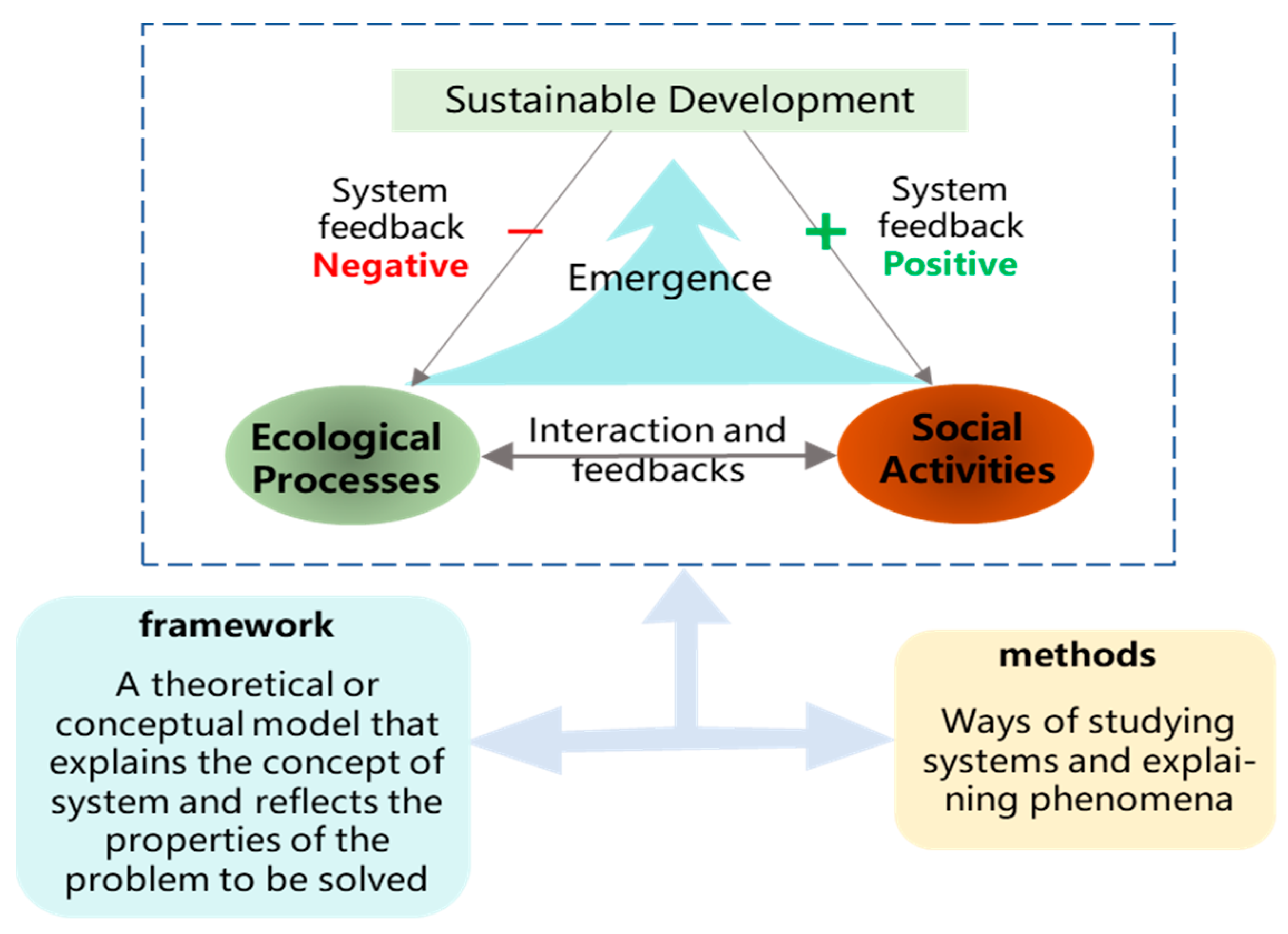

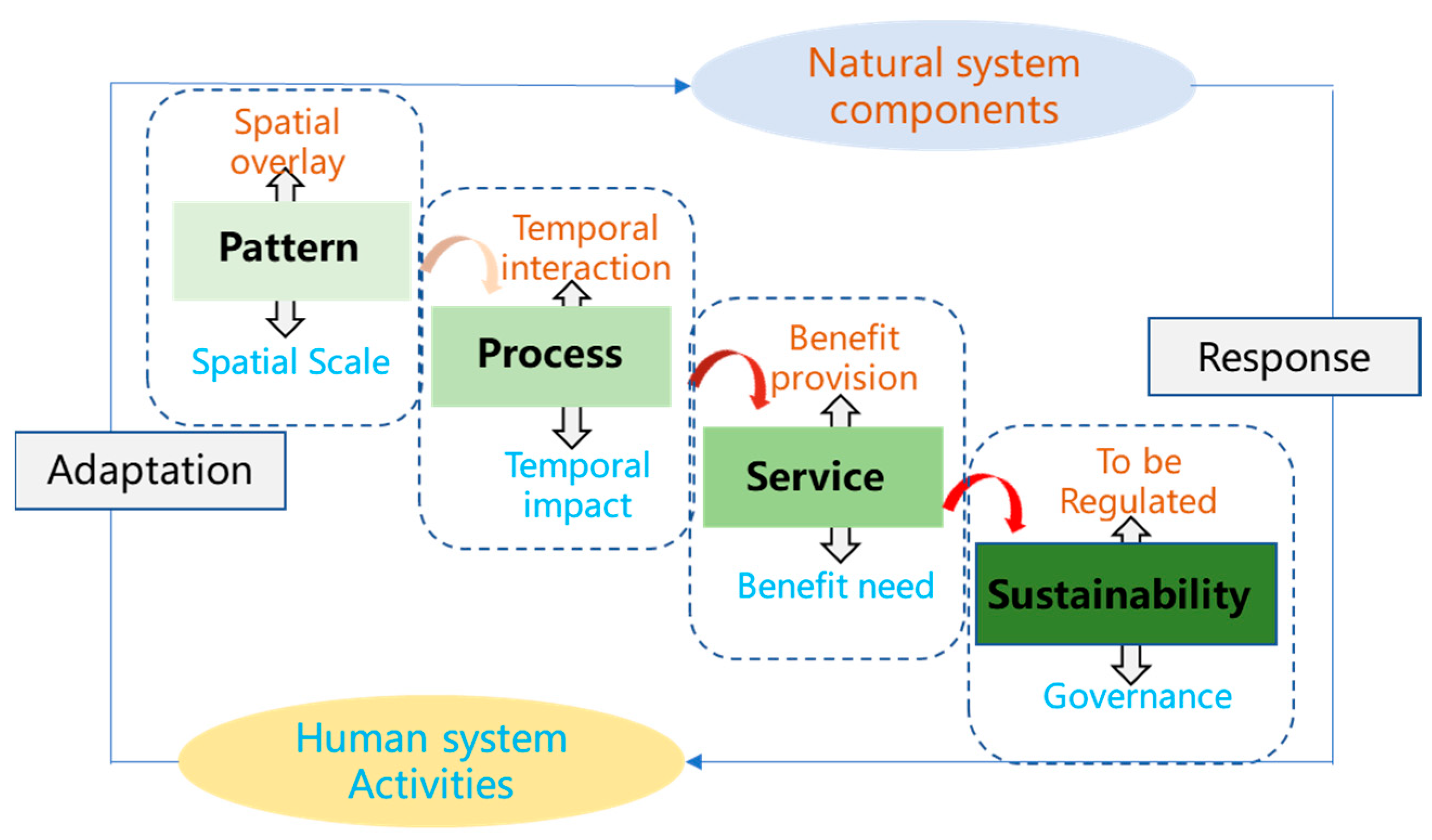
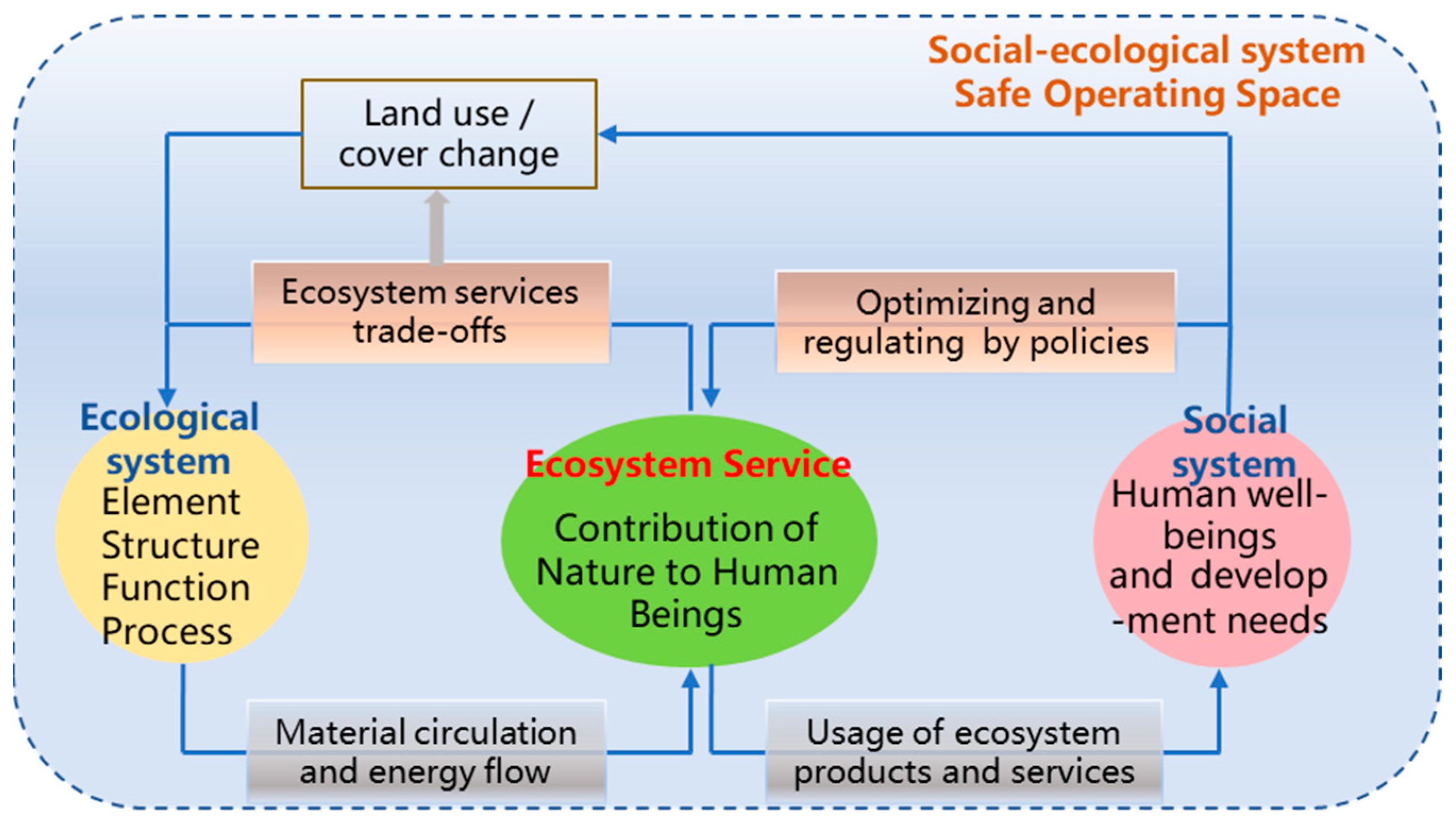


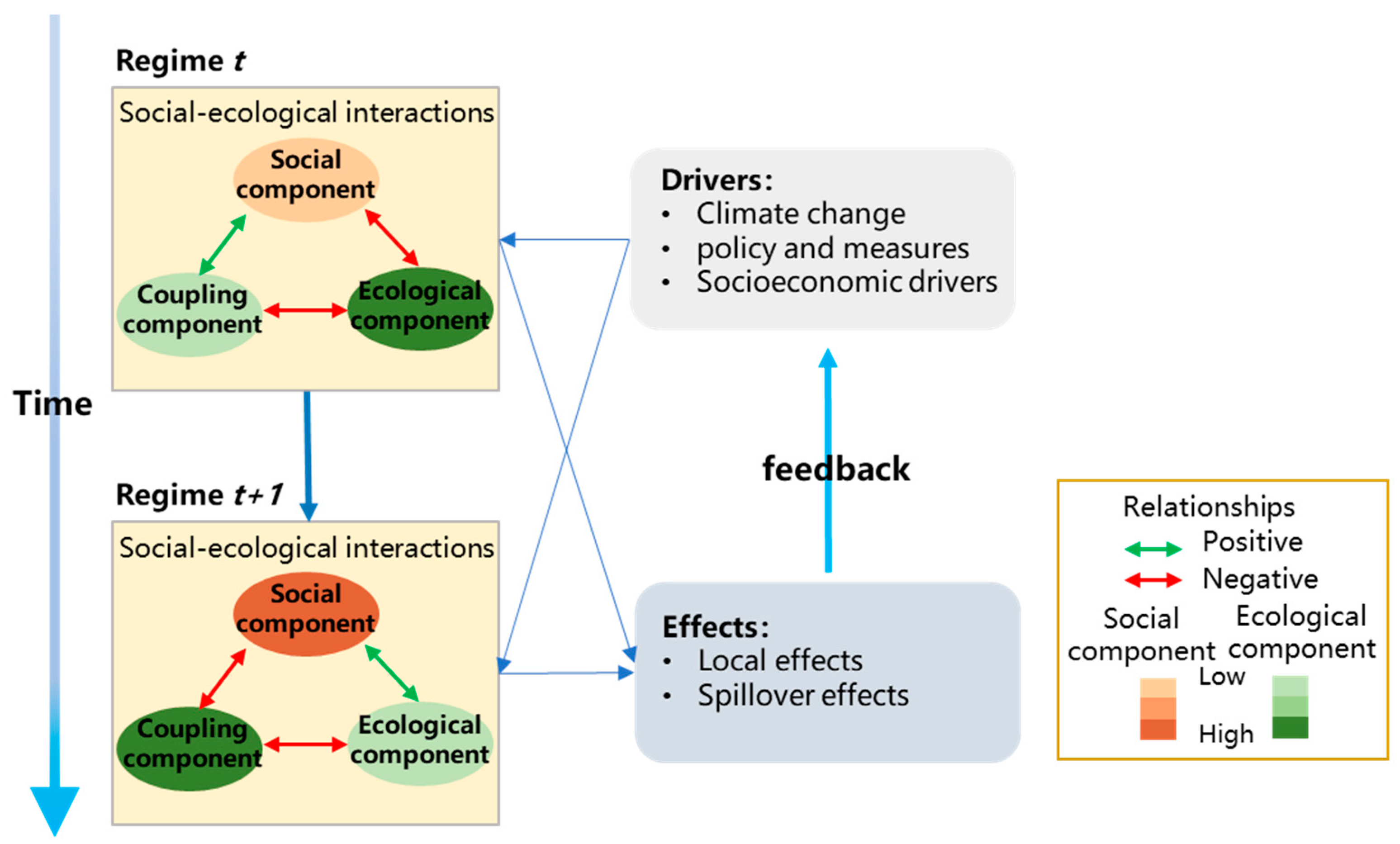
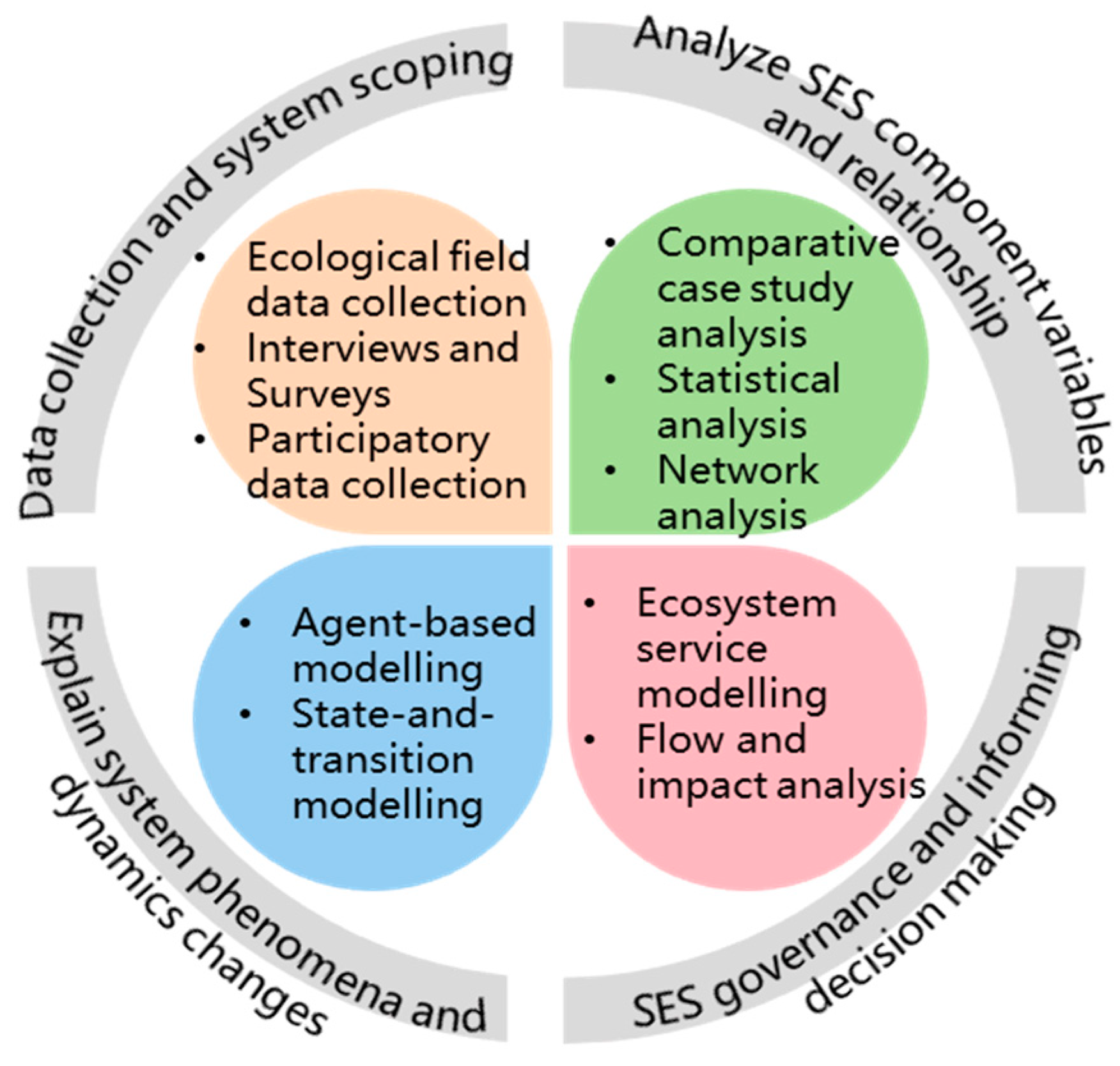
| Rules | Description |
|---|---|
| Relationships over individuals | The nature and trend of the system as a whole can be better understood by clarifying the relationship between the components than by understanding the idiosyncratic characteristics of the individual components |
| Adaptability | Many relationships in the system have feedback processes and response mechanisms so that the system can constantly adjust its state to adapt to environmental changes and external forces |
| Nonlinear correlation | The change of small elements will lead to the large-scale, continuous, and sudden unexpected restructuring of SES structure and function, and ultimately lead to the reform of the whole system |
| Boundaryless | SES has a profound interaction and connection with the broader environment, and the boundaries of the system often depend on the researcher’s purpose, the observer’s perspective, and the characteristics of the research problem |
| Situational dependence | Elements and indicators in the system will assume different roles and functions according to time sequence and context |
| Complex causal relationship | Causality in SES is not unidirectional or linear but marked by a complex recursive causal path. This leads to SES not always being an accurate thorough understanding, and the property nature of the system is unpredictable |
| Research Objectives | Methods and Tools | Application and References |
|---|---|---|
| Data collection and system scoping | Ecological field data collection | The most direct and objective first-hand data can be obtained for understanding the structure and processes of the natural ecological environment and the impact of human activities on disturbance, etc. [75]. |
| Interviews and surveys | Focuses on the collection of person-related information, generating qualitative data and regular experiences to understand the assessment of long-term social, economic, and cultural changes in SES [62] | |
| Participatory data collection | Stakeholders in regional socio-ecological systems are themselves part of the problem to be solved, and researchers should focus on co-producing knowledge with them [76] | |
| Analyze SES component variables and relationship | Comparative case study analysis | Qualitative, comparative, empirical meta-analysis will provide a deeper understanding of the complexity of SES [6] Direct comparisons guided by an SES framework [53,59,63] |
| Statistical analysis | Processing and application of collected data with mathematical tools, identifying control parameters of social and ecological factors, testing hypothesis problems and forecasting future trends | |
| Network analysis | Linking society and ecological processes to analyze how patterns of linkage vary among nodes, and how variation in connectedness influences the behavior of network nodes [77] | |
| Explain system phenomena and dynamics changes | Agent-based modeling | One of the key methods to study emergent phenomena of systems: the agents often represent individual or collective actors or biological organisms, the social environment comprises social structures, the biophysical environment represents natural resources or ecosystems that are used or affected by the behavior of the agents [78] |
| State-and-transition modeling | Explains the causes and consequences of ecosystem change by simulating the effects of external drivers (such as climate) and human activities (such as management action) [79] | |
| SES governance and informing decision making | Ecosystem service modeling | Integrated valuation of ecosystem services and trade-offs Identify areas for conservation, utilization, or restoration based on the balance between supply and demand of ecosystem services in the region [80] |
| Flow and impact analysis | Measuring the relationship between resource flows and human society and monitoring the linkages between ecosystems and human well-being |
Disclaimer/Publisher’s Note: The statements, opinions and data contained in all publications are solely those of the individual author(s) and contributor(s) and not of MDPI and/or the editor(s). MDPI and/or the editor(s) disclaim responsibility for any injury to people or property resulting from any ideas, methods, instructions or products referred to in the content. |
© 2023 by the authors. Licensee MDPI, Basel, Switzerland. This article is an open access article distributed under the terms and conditions of the Creative Commons Attribution (CC BY) license (https://creativecommons.org/licenses/by/4.0/).
Share and Cite
Liu, F.; Dai, E.; Yin, J. A Review of Social–Ecological System Research and Geographical Applications. Sustainability 2023, 15, 6930. https://doi.org/10.3390/su15086930
Liu F, Dai E, Yin J. A Review of Social–Ecological System Research and Geographical Applications. Sustainability. 2023; 15(8):6930. https://doi.org/10.3390/su15086930
Chicago/Turabian StyleLiu, Fang, Erfu Dai, and Jun Yin. 2023. "A Review of Social–Ecological System Research and Geographical Applications" Sustainability 15, no. 8: 6930. https://doi.org/10.3390/su15086930
APA StyleLiu, F., Dai, E., & Yin, J. (2023). A Review of Social–Ecological System Research and Geographical Applications. Sustainability, 15(8), 6930. https://doi.org/10.3390/su15086930






